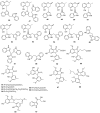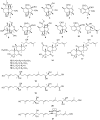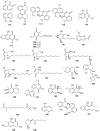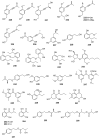Structures and Biological Activities of Secondary Metabolites from Daldinia spp
- PMID: 39728329
- PMCID: PMC11677690
- DOI: 10.3390/jof10120833
Structures and Biological Activities of Secondary Metabolites from Daldinia spp
Abstract
The genus Daldinia have long been recognized as a source of structural novel, pharmaceutically relevant natural products. We reviewed the structures and activities of secondary metabolites isolated from the genus of Daldinia from January 1995 to June 2024, and 280 compounds, including six major categories-terpenoids, alkaloids, polyketides, polyphenols, steroids, and other classes-are presented in this review. Among these metabolites, 196 were identified as new structures. Remarkably, 112 compounds exhibited a range of biological activities, including cytotoxic, antimicrobial, anti-inflammatory, antifungal, anti-virus, and enzyme-inhibitory activities. This review highlights the bioactive metabolites discovered in the past three decades from the genus of Daldinia while also exploring the potential of these symbiotic fungi as rich sources of novel and diverse natural products. The varying bioactivities of these metabolites offer a vast array of promising lead compounds and also could significantly contribute to the development of new medicines.
Keywords: Daldinia sp.; bioactivity; secondary metabolites.
Conflict of interest statement
The authors declare no competing financial interests.
Figures



























Similar articles
-
Structures and Biological Activities of Secondary Metabolites from Xylaria spp.J Fungi (Basel). 2024 Feb 29;10(3):190. doi: 10.3390/jof10030190. J Fungi (Basel). 2024. PMID: 38535199 Free PMC article. Review.
-
Secondary metabolites of the genus Nigrospora from terrestrial and marine habitats: Chemical diversity and biological activity.Fitoterapia. 2022 Sep;161:105254. doi: 10.1016/j.fitote.2022.105254. Epub 2022 Jul 21. Fitoterapia. 2022. PMID: 35872163 Review.
-
Secondary Metabolites from the Mangrove Ecosystem-Derived Fungi Penicillium spp.: Chemical Diversity and Biological Activity.Mar Drugs. 2024 Dec 26;23(1):7. doi: 10.3390/md23010007. Mar Drugs. 2024. PMID: 39852509 Free PMC article. Review.
-
The Genus Cladosporium: A Prospective Producer of Natural Products.Int J Mol Sci. 2024 Jan 29;25(3):1652. doi: 10.3390/ijms25031652. Int J Mol Sci. 2024. PMID: 38338931 Free PMC article. Review.
-
Specialized metabolites of the fungal genus Phomopsis: Structures, bioactivities and biosynthesis.Fitoterapia. 2023 Jul;168:105523. doi: 10.1016/j.fitote.2023.105523. Epub 2023 May 3. Fitoterapia. 2023. PMID: 37146734 Review.
Cited by
-
Taxonomy, phylogeny, and bioactive potential of Xylariales (Sordariomycetes, Ascomycota) from Thailand: novel species discovery, new host and geographical records, and antibacterial properties.MycoKeys. 2025 Jul 29;120:35-117. doi: 10.3897/mycokeys.120.155915. eCollection 2025. MycoKeys. 2025. PMID: 40778230 Free PMC article.
-
New Bioactive Polyketides from the Mangrove-Derived Fungus Daldinia eschscholzii HJX1P2.Mar Drugs. 2025 May 30;23(6):238. doi: 10.3390/md23060238. Mar Drugs. 2025. PMID: 40559647 Free PMC article.
-
Litter Decomposition in Pacific Northwest Prairies Depends on Fire, with Differential Responses of Saprotrophic and Pyrophilous Fungi.Microorganisms. 2025 Aug 6;13(8):1834. doi: 10.3390/microorganisms13081834. Microorganisms. 2025. PMID: 40871338 Free PMC article.
References
-
- Kong D.W., Niu R.C., Mao Y.Z., Liu L.L. Research progress on active metabolites of endophytes. Heilongjiang Agric. Sci. 2019;12:151–154.
-
- Kellogg J.J., Raja H.A. Endolichenic fungi: A new source of rich bioactive secondary metabolites on the horizon. Phytochem. Rev. 2017;16:271–293. doi: 10.1007/s11101-016-9473-1. - DOI
Publication types
Grants and funding
LinkOut - more resources
Full Text Sources
Miscellaneous

